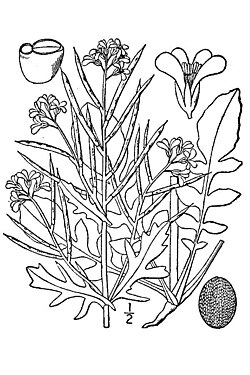Barbarea verna
| Lifespan: | ⌛ | biennial |
|---|---|---|
| Origin: | ✈ | SW Europe |
|
Barbarea > |
verna > |
If this plant info box on watering; zones; height; etc. is mostly empty you can click on the edit tab and fill in the blanks!
Land cress (Barbarea verna), also known as American cress, bank cress, Belle Isle cress, Bermuda cress, early yellowrocket, early wintercress, scurvy cress, and upland cress, is a biennial herb in the family Brassicaceae. It is native to southwestern Europe, but is also cultivated in Florida. As it requires less water than watercress, it is easier to cultivate. Land cress has been cultivated as a leaf vegetable in England since the 17th century.
Land cress is considered a satisfactory substitute for watercress. It can be used in sandwiches, or salads, or cooked like spinach, or used in soup.
Land cress can be grown easily in any garden. Like watercress, it loves water, but does not do well when partially submerged for long periods of time. This perennial needs full sun and frequent watering in any garden, unless near a direct source of water.
Synonyms include Barbarea praecox and Lepidum nativum. Other common names include dryland cress, cassabully, and American watercress. A variegated form is available.
Read about Barbarea verna in the Standard Cyclopedia of Horticulture
|
|---|
|
Barbarea praecox, R. Br. (B. verna, Asch.). Early Winter, or Bell Isle Cress. Distinguished by the more numerous divisions of the Lvs. (4-8 pairs) and thickened pedicels. Slightly cult. as a winter salad, and known S. as scurvy grass. Naturalized from Eu.
|
Cultivation
The plant easily self seeds on a neutral soil.
Propagation
By seed
Pests and diseases
Very resistant to club root and insect attacks (whitefly, cabbage root fly, and cabbage white butterfly, and cabbage moths)
Varieties
Synonyms include Barbarea praecox and Lepidum nativum.
Gallery
If you have a photo of this plant, please upload it! Plus, there may be other photos available for you to add.
References
External links
- w:Barbarea verna. Some of the material on this page may be from Wikipedia, under the Creative Commons license.
- Barbarea verna QR Code (Size 50, 100, 200, 500)
